Unified mobile device interface
Loud probably the name, but its essence lies in my recent comments on Habré:
Who is interested in the concept, please under the cat
What I tell you is my idea of the ideal interface of a socially oriented smartphone, i.e. devices designed for people actively using social networks and are constantly online. Something has been done, something has been done and forgotten, it is even possible that all this already exists in the active stage, and I missed it. Also, I will not touch the technical part, but I will tell only about what is visible on the surface.

So, what is happening now on popular mobile platforms (I apologize, judging by Android) - dozens of applications for all sorts of social networks and services that live their lives in the operating system environment of the device, integrating into it through sharing capabilities (for example, send a photo from the gallery). on facebook) and occasionally taking action (for example, a call to a mobile phone via skype).
And what would like to see. And you want to see not individual applications, but plug-ins to already prepared interfaces for typical tasks, such as text messaging, viewing friends' tapes, events, address book, and the like, present in all social networks, forums, blogs to some extent.
')
In order not to reinvent the wheel, let us remember which of the projects already had similar functionality. Nokia n900 comes to mind with maemo on board, webOS from the late Palm with Synergy technology, and perhaps the Linux social networking client gwibber and any multi-protocol chat client.
Nokia n900 provides a single interface to address book, text messages, audio and video calls for such popular means of communication as Skype, Google Talk, Facebook, Jabber, SIP, AIM, MSN, VK, Yahoo, etc. To connect to these communication systems, just go to the phone settings and enter your username and password (for some you need to first install the plugin from the official maemo repository - ala google play).

After that, going into the address book of the device, we will see our friends, for example from Skype and Google Talk, as well as their statuses and avatars. When you click on a contact, the phone will offer to call, chat, send something by email, etc.
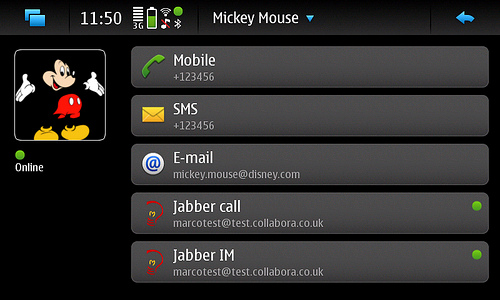
Of course, this does not surprise anyone, but the most important thing is that for all this the phone will not run separate applications, you will not see all kinds of dialer and chat interfaces for each of the communication methods, but you will see
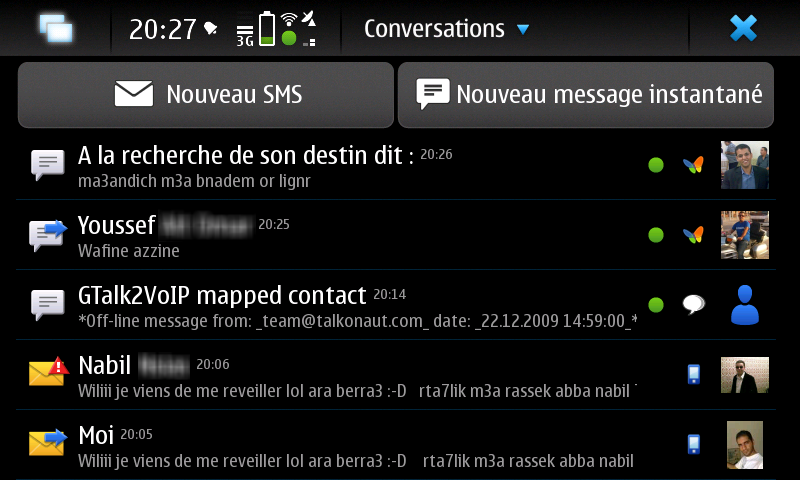
that's for text

that's the audio call

and so for a video call
Frankly, after such beauty in the n900, the installation options for individual applications with their address books and the zoo of user interfaces seem wild, not to mention the fact that applications may not have autoload or fall out of the device’s memory, making it impossible to communicate with you.
WebOS and the main feature is Synergy technology. It’s better to watch a video presentation once, than to read a bunch of text.
The essence of the system is the integration of information from different sources (mail, calendar, address book) and the ability to communicate with friends without switching between separate applications.
gwibber is a social networking client (microblogging) for the GNOME environment (and of Unity on Ubuntu in combination).

Allows you to see the tape posts and personal messages of friends and acquaintances in the same application, just as any multiprotocol messenger (miranda or pidgin) allows you to communicate with people sitting through different protocols without installing dozens of different clients on your computer.
The comments suggest that Windows Phone already has similar features.
Like the Blackberry 10 Hub
It remains an open question about adding your sources (social networks, blogs, PIM, etc.) and combining information from them.
And I want all the above advantages to work at the operating system level, which would provide one unified interface for all typical tasks. I think everyone can see that social networks, blogs, forums and instant messaging systems differ from each other only in design, and in fact are a collection:
Therefore, I do not see much point in the current version of holding a heap of programs for each of these items or groups of items on the phone.
Almost perfect main screen was at Palm. It contained a calendar, a to-do list, new messages, and of course a date and time.
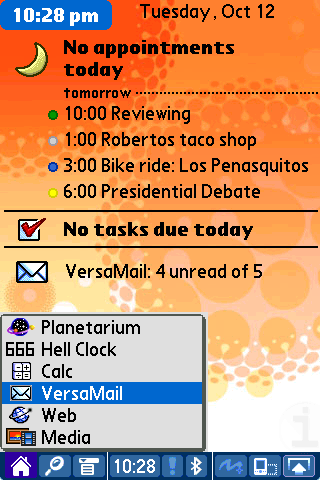
To this ideal, it is worthwhile to add a panel of large buttons with a quick transition to selected applications. As well as gestures to go to the address book and the tape of events (for example, left / right).

And do not forget about quick access to the settings and the list of alerts, as is done in Android and other mobile OC.
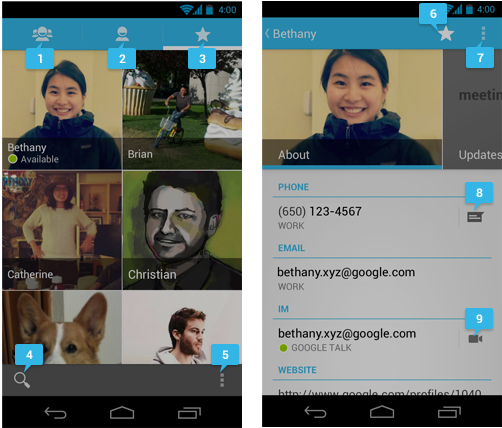
A normal address book with a quick search for contacts, the ability to add contacts to favorites (and then quick dial / select), search (including voice) alphabetically and various contact fields, contact status and group them (for example, This is done in google +). The main task of the address book is to enable a quick transition to communication systems with a person, while sorting the list of possible connections, taking into account the availability of the subscriber and frequent ways of communicating with him. For example, if you communicate with Vasya mainly via skype, then it makes no sense to put chat on facebook on the first line, just as there is no sense to put skype in the first place, if the contact is offline.

If you have already watched the video above (about webOS), then you already know the general appearance and possibilities of the calendar. To the event itself in the calendar, you should add the ability to quickly communicate with the participants of the event, as well as the data associated with this event. For example, you have a meeting with classmates and people from your address book, photos and videos (after the event), links to entertainment / contests sites at such events (attention to the way of monetization) are attached to this event. Another example: you have a speech in front of you (teacher, commission, board of directors) and files like presentation and speech are attached to this event.
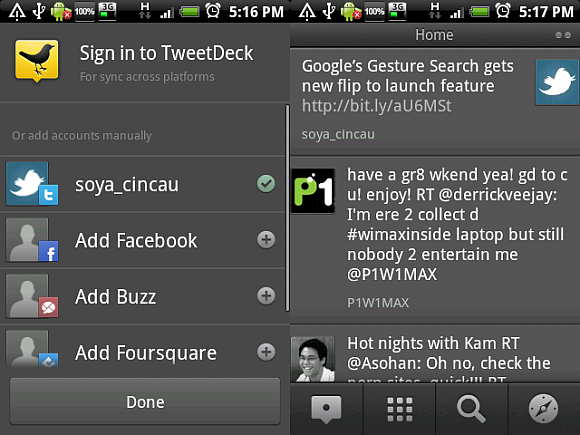
Here it is already more difficult, because in the nude it will be a bunch of everything and everything that can no longer be discerned what is interesting and important, and what is not needed repost or outright spam. So far I can only see the separation of all messages into user groups and the merging (or ignoring) of similar messages. Each entry in the tape is the main message and (after clicking) discussion, so you can push not only micro messages from facebook / twitter / vk, but also full posts from LJ and Habr or forum topics.
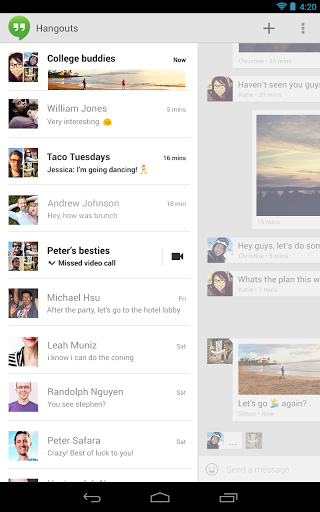
It's much easier here - chats are sorted by the frequency of communication with a person, audio and video calls are an integral part of the address book and chat windows (so that you can call from it). Chat in Africa and chat, the main thing is to provide opportunities for group communication and features like inserting multimedia data into the body of a chat message (pictures, emoticons, video).

There is an obvious favorite - the gmail web interface, and it should be taken as a basis with the possibility of combining messages by topic, filters, folders. As well as the ability to transfer data from a letter to a calendar, to-do list or address book.

All photos, videos, notes / notes, user's documents, sorted by groups, dates, frequency of circulation (relevance) are stored here. In this case, the source for the gallery can serve as a folder on the memory card, as well as a folder / document from the cloud storage, a photo album from a social network or photo hosting site or your blog entry. I think about the button “send to / on ...”, it’s not necessary to write “sharing”, because This has long been implemented in any modern mobile operating system. Perhaps it is worth separating photos and videos from documents.
The first and probably the most important joint is how to digest and combine this mountain of data from various sources.
Another problem arises from the first, how to give information back to sources. Most likely, it will be necessary to determine which groups of users the information given is intended (and whether it is intended at all to someone) and disseminate to appropriate sources. For example, if you want to show photos from your vacation to friends who are sitting on LiveJournal and VKontakte, then it makes no sense to upload the same photos in flickr and google +. Another example is that you have several calendars in various sources (google calendar, exchange at work and events you are invited to on facebook), similar to the previous example - you should not synchronize everything with everything so that tasks from the production server do not become a page in facebook.
Also, the phone should have some kind of personal storage in order to synchronize it with the client on a home computer or other phone, in conditions when cloud sources are not available (they fell off or the phone is offline ... or the user of the social phone is afraid of spying on them from providers whose accounts he uses).
Here is my vision of a mobile device with a single interface for each of the typical tasks. Of course, some of this is implemented in one way or another in mobile operating systems or individual applications, but I have not yet seen a single integrity. I did not specifically mention the individual applications, they are more difficult to integrate into this environment and they will be separate programs through which you can make some manipulations with photos / videos / documents. A game ... Is that the save and achievements stored in the cloud or make an interface to systems like Steam.
What will say habragraod?
Corrections in terms of grammar and punctuation are welcome in PM
And I would like all kinds of messengers not to be separate applications or to be built into the system, but to be plug-ins to a single device interface. Those. it is now clear that there is a chat, audio and video call, as well as a tape of friends with all sorts of photos and reposts, a photo / video album and other entities in one form or another found in various applications. Therefore, it would be great to have it in a single device interface (nokia n900 owners will understand me). Those. I do not want to worry me in which social network this or that friend and / or what means of communication with him, I want to click on a friend in a single address book and start chatting with him or share a photo or see what new photos he has posted.
Who is interested in the concept, please under the cat
What I tell you is my idea of the ideal interface of a socially oriented smartphone, i.e. devices designed for people actively using social networks and are constantly online. Something has been done, something has been done and forgotten, it is even possible that all this already exists in the active stage, and I missed it. Also, I will not touch the technical part, but I will tell only about what is visible on the surface.

So, what is happening now on popular mobile platforms (I apologize, judging by Android) - dozens of applications for all sorts of social networks and services that live their lives in the operating system environment of the device, integrating into it through sharing capabilities (for example, send a photo from the gallery). on facebook) and occasionally taking action (for example, a call to a mobile phone via skype).
And what would like to see. And you want to see not individual applications, but plug-ins to already prepared interfaces for typical tasks, such as text messaging, viewing friends' tapes, events, address book, and the like, present in all social networks, forums, blogs to some extent.
')
It happened before
In order not to reinvent the wheel, let us remember which of the projects already had similar functionality. Nokia n900 comes to mind with maemo on board, webOS from the late Palm with Synergy technology, and perhaps the Linux social networking client gwibber and any multi-protocol chat client.
Nokia n900 provides a single interface to address book, text messages, audio and video calls for such popular means of communication as Skype, Google Talk, Facebook, Jabber, SIP, AIM, MSN, VK, Yahoo, etc. To connect to these communication systems, just go to the phone settings and enter your username and password (for some you need to first install the plugin from the official maemo repository - ala google play).

After that, going into the address book of the device, we will see our friends, for example from Skype and Google Talk, as well as their statuses and avatars. When you click on a contact, the phone will offer to call, chat, send something by email, etc.

Of course, this does not surprise anyone, but the most important thing is that for all this the phone will not run separate applications, you will not see all kinds of dialer and chat interfaces for each of the communication methods, but you will see

that's for text

that's the audio call

and so for a video call
Frankly, after such beauty in the n900, the installation options for individual applications with their address books and the zoo of user interfaces seem wild, not to mention the fact that applications may not have autoload or fall out of the device’s memory, making it impossible to communicate with you.
WebOS and the main feature is Synergy technology. It’s better to watch a video presentation once, than to read a bunch of text.
The essence of the system is the integration of information from different sources (mail, calendar, address book) and the ability to communicate with friends without switching between separate applications.
gwibber is a social networking client (microblogging) for the GNOME environment (and of Unity on Ubuntu in combination).

Allows you to see the tape posts and personal messages of friends and acquaintances in the same application, just as any multiprotocol messenger (miranda or pidgin) allows you to communicate with people sitting through different protocols without installing dozens of different clients on your computer.
The comments suggest that Windows Phone already has similar features.
Some of this was done on Windows Phone 7 and later added to the G8 — a single news feed, contact list, profile data in contacts, etc. from Facebook, Linkedin and Twitter. Facebook chat, for example, was integrated into the SMS application in a single thread for the contact.
Like the Blackberry 10 Hub
It remains an open question about adding your sources (social networks, blogs, PIM, etc.) and combining information from them.
What do i want
And I want all the above advantages to work at the operating system level, which would provide one unified interface for all typical tasks. I think everyone can see that social networks, blogs, forums and instant messaging systems differ from each other only in design, and in fact are a collection:
- address book,
- news feeds
- calendar and to-do list
- interest groups
- personal multimedia data (photo albums, videos, documents),
- private or group communication (chat, audio and video calls, mail),
- "I was here,"
- entertainment (music, movies, books ... with games more difficult).
Therefore, I do not see much point in the current version of holding a heap of programs for each of these items or groups of items on the phone.
As I can see...
Main screen
Almost perfect main screen was at Palm. It contained a calendar, a to-do list, new messages, and of course a date and time.

To this ideal, it is worthwhile to add a panel of large buttons with a quick transition to selected applications. As well as gestures to go to the address book and the tape of events (for example, left / right).

And do not forget about quick access to the settings and the list of alerts, as is done in Android and other mobile OC.
The address book

A normal address book with a quick search for contacts, the ability to add contacts to favorites (and then quick dial / select), search (including voice) alphabetically and various contact fields, contact status and group them (for example, This is done in google +). The main task of the address book is to enable a quick transition to communication systems with a person, while sorting the list of possible connections, taking into account the availability of the subscriber and frequent ways of communicating with him. For example, if you communicate with Vasya mainly via skype, then it makes no sense to put chat on facebook on the first line, just as there is no sense to put skype in the first place, if the contact is offline.
Calendar and to-do list

If you have already watched the video above (about webOS), then you already know the general appearance and possibilities of the calendar. To the event itself in the calendar, you should add the ability to quickly communicate with the participants of the event, as well as the data associated with this event. For example, you have a meeting with classmates and people from your address book, photos and videos (after the event), links to entertainment / contests sites at such events (attention to the way of monetization) are attached to this event. Another example: you have a speech in front of you (teacher, commission, board of directors) and files like presentation and speech are attached to this event.
news feed

Here it is already more difficult, because in the nude it will be a bunch of everything and everything that can no longer be discerned what is interesting and important, and what is not needed repost or outright spam. So far I can only see the separation of all messages into user groups and the merging (or ignoring) of similar messages. Each entry in the tape is the main message and (after clicking) discussion, so you can push not only micro messages from facebook / twitter / vk, but also full posts from LJ and Habr or forum topics.
Chats, audio / video calls

It's much easier here - chats are sorted by the frequency of communication with a person, audio and video calls are an integral part of the address book and chat windows (so that you can call from it). Chat in Africa and chat, the main thing is to provide opportunities for group communication and features like inserting multimedia data into the body of a chat message (pictures, emoticons, video).
post office

There is an obvious favorite - the gmail web interface, and it should be taken as a basis with the possibility of combining messages by topic, filters, folders. As well as the ability to transfer data from a letter to a calendar, to-do list or address book.
Gallery

All photos, videos, notes / notes, user's documents, sorted by groups, dates, frequency of circulation (relevance) are stored here. In this case, the source for the gallery can serve as a folder on the memory card, as well as a folder / document from the cloud storage, a photo album from a social network or photo hosting site or your blog entry. I think about the button “send to / on ...”, it’s not necessary to write “sharing”, because This has long been implemented in any modern mobile operating system. Perhaps it is worth separating photos and videos from documents.
Shoals
The first and probably the most important joint is how to digest and combine this mountain of data from various sources.
Another problem arises from the first, how to give information back to sources. Most likely, it will be necessary to determine which groups of users the information given is intended (and whether it is intended at all to someone) and disseminate to appropriate sources. For example, if you want to show photos from your vacation to friends who are sitting on LiveJournal and VKontakte, then it makes no sense to upload the same photos in flickr and google +. Another example is that you have several calendars in various sources (google calendar, exchange at work and events you are invited to on facebook), similar to the previous example - you should not synchronize everything with everything so that tasks from the production server do not become a page in facebook.
Also, the phone should have some kind of personal storage in order to synchronize it with the client on a home computer or other phone, in conditions when cloud sources are not available (they fell off or the phone is offline ... or the user of the social phone is afraid of spying on them from providers whose accounts he uses).
Here is my vision of a mobile device with a single interface for each of the typical tasks. Of course, some of this is implemented in one way or another in mobile operating systems or individual applications, but I have not yet seen a single integrity. I did not specifically mention the individual applications, they are more difficult to integrate into this environment and they will be separate programs through which you can make some manipulations with photos / videos / documents. A game ... Is that the save and achievements stored in the cloud or make an interface to systems like Steam.
What will say habragraod?
Corrections in terms of grammar and punctuation are welcome in PM
Source: https://habr.com/ru/post/180751/
All Articles